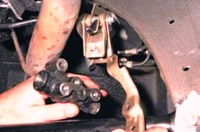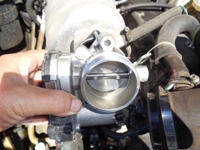The presence of a malfunction is signaled by the on-board diagnostic system by turning on the indicator
Then, the on-board diagnostic system must provide, using special equipment, the receipt of diagnostic information stored in the controller's memory

For this purpose, a serial information transmission channel is organized in the engine control system, which includes an ECM controller, a standardized block for connecting a diagnostic tool and a wire (K-line) connecting them.
In addition to the block, the protocol for transmitting information and the format of transmitted messages are also standardized.
In addition to receiving information about detected malfunctions and the state of the engine management system, the on-board diagnostics system allows you to perform a number of verification tests by controlling the actuators.
The heart of the OBD system is the ECM.
In addition to its main task (controlling the combustion of the fuel mixture), it performs self-diagnosis.
When performing this function, the controller monitors the signals of various sensors and actuators of the ECM.
These signals are compared with control values stored in the controller's memory.
If any signal goes beyond the control values, then the controller evaluates this condition as a malfunction (for example, the voltage at the sensor output has become equal to zero - a short circuit to ground), generates and writes the appropriate diagnostic information to the error memory, turns on the control lamp (signaling device) for indicating malfunctions, and also switches to emergency modes of operation of the ECM.
The on-board diagnostic system starts to function from the moment the ignition is turned on and stops after the controller switches to the "standby" mode (comes after the main relay is turned off).
The moment of activation of one or another diagnostic algorithm and its operation are determined by the corresponding engine operating modes. Diagnostic algorithms can be divided into three groups:
- 1) Sensor diagnostics. The controller, monitoring the value of the output signal of the sensor, determines the presence or absence of a malfunction.
- 2) Diagnostics of the ECM actuators (driver diagnostics). The controller checks the control circuits for an open, short to ground, or power supply.
- 3) Diagnostics of ECM subsystems (functional diagnostics).
In the engine management system, several subsystems can be distinguished - ignition, fuel supply, idle speed maintenance, exhaust gas aftertreatment, gasoline vapor recovery, etc. Functional diagnostics gives a conclusion about the quality of their work.
In this case, the system no longer monitors individual sensors or actuators, but the parameters that characterize the operation of the entire subsystem as a whole.
For example, the quality of the ignition subsystem can be judged by the presence of misfires in the combustion chambers of the engine.
The fuel adaptation parameters provide information about the state of the fuel subsystem.
Each of the subsystems has its own requirements for the maximum allowable deviations of its parameters from the average values.
Fault indicator
The malfunction indicator on Chevrolet Niva cars is located in the instrument cluster.
Turning on of the signaling device indicates that the on-board diagnostic system has detected a malfunction of the ECM and further movement of the vehicle occurs in emergency mode.
A flashing warning light indicates a malfunction that can cause serious damage to the ECM (for example, a misfire can damage the catalytic converter).
When the ignition is turned on, the indicator should light up - this is how the ECM checks the condition of the indicator and its control circuit.
After starting the engine, the indicator should go out if there are no conditions for turning it on in the controller's memory.
To protect against random, transient errors that may be caused by loss of contact in electrical connectors or unstable engine operation, the warning lamp turns on after a certain period of time after an ECM malfunction is detected.
During this period, the on-board diagnostic system checks for a malfunction.
After eliminating the causes of the malfunction, the indicator will turn off after a certain delay time, during which the malfunction does not appear, and provided that there are no other codes in the controller’s memory malfunctions that require the signaling device to be turned on.
Me17.9.71 controller diagnostic codes
- P0030 DC heater to the converter, the circuit is faulty
- Р0031 DC heater to neutralizer, control circuit short to ground
- Р0032 DC heater to the neutralizer, short circuit of the control circuit to the on-board network
- P0036 DC heater after the converter, the circuit is faulty
- P0037 DC heater after converter, control circuit short to ground
- Р0038 DC heater after the converter, short circuit of the control circuit to the on-board network
- P0101 MAF circuit, signal out of range
- P0102 Mass Air Flow Sensor Circuit Low
- P0103 Mass Air Flow Sensor Circuit High
- P0112 Intake air temperature sensor circuit low
- P0113 Intake air temperature sensor circuit high
- P0116 DTOZH circuit, signal out of range
- P0117 DTOZH circuit low signal
- P0118 DTOZH circuit high signal
- P0122 TPS A Circuit Low Signal
- P0123 TPS A Circuit High Signal
- P0130 Oxygen sensor upstream of the converter is defective
- P0131 DC circuit to neutralizer, low output level
- P0132 DC circuit to neutralizer, high output level
- P0133 DC circuit to the converter, slow response to changes in the composition of the mixture
- P0134 Pre-converter oxygen sensor circuit inactive
- P0135 Pre-converter oxygen sensor, heater defective
- P0136 Post catalytic converter defective
- P0137 DC circuit after converter, low signal level
- P0138 DC circuit after converter, high signal level
- P0140 Post catalytic converter oxygen sensor circuit inactive
- P0141 Post catalytic converter oxygen sensor, heater defective
- P0171 Fuel system too lean
- P0172 Fuel system too rich
- P0201 Cylinder 1 injector, circuit faulty
- P0202 Cylinder 2 injector, circuit faulty
- P0203 Cylinder 3 injector, circuit faulty
- P0204 Cylinder 4 injector, circuit faulty
- P0217 Engine temperature too high
- P0222 TPS B circuit low signal
- P0223 TPS B Circuit High Signal
- P0261 Cylinder 1 injector control circuit short to ground
- P0262 Cylinder 1 injector, control circuit short to on-board network
- P0264 Cylinder 2 injector control circuit short to ground
- P0265 Cylinder 2 injector, control circuit short to on-board network
- P0267 Cylinder 3 injector control circuit short to ground
- P0268 Cylinder 3 injector, control circuit short to on-board network
- P0270 Cylinder 4 injector control circuit short to ground
- P0271 Cylinder 4 injector, control circuit short to vehicle network
- P0300 Random/Multiple Misfires Detected
- P0301 Cylinder 1 misfire detected
- P0302 Cylinder 2 misfire detected
- P0303 Cylinder 3 misfire detected
- P0304 Cylinder 4 misfire detected
- P0327 Knock sensor circuit low
- P0335 Crankshaft Position Sensor Circuit Faulty
- P0340 Phase sensor defective
- P0351 Cylinder 1-4 ignition coil open control circuit
- P0352 Cylinder 2-3 ignition coil open control circuit
- P0363 Misfire detected, idle cylinders cut off
- P0422 Catalyst efficiency below threshold
- P0441 Gasoline vapor recovery system, incorrect air flow through the CPA
- P0444 Canister purge valve, control circuit open
- P0458 Canister purge valve, control circuit short to ground
- P0459 Canister purge valve, short circuit control circuit to the on-board network
- P0480 Fan relay 1 open control circuit
- P0481 Fan 2 relay, open control circuit
- P0500 Vehicle speed sensor defective
- P0501 Vehicle speed sensor out of range
- P0504 Brake pedal A/B switches, signal mismatch
- P0532 A/C pressure sensor low
- P0533 A/C pressure sensor circuit high
- P0560 Vehicle electrical system voltage
- P0561 On-board network voltage is unstable
- P0562 Vehicle voltage low
- P0563 Vehicle voltage high
- P0606 ECM controller, ADC malfunction
- P0615 Add. starter relay, open control circuit
- P0616 Add. starter relay, control circuit short to ground
- P0617 Add. starter relay, control circuit short to vehicle network
- P0627 Fuel pump relay, open control circuit
- P0628 Fuel pump relay, control circuit short to ground
- P0629 Fuel pump relay, control circuit short to vehicle network
- P0645 A/C compressor clutch relay, control circuit open
- P0646 A/C compressor clutch relay, control circuit short to ground
- P0647 A/C compressor clutch relay, control circuit short to vehicle power
- P0691 Fan 1 relay, control circuit short to ground
- P0692 Fan relay 1, control circuit short to vehicle network
- P0693 Fan 2 relay, control circuit short to ground
- P0694 Fan 2 relay, control circuit short to vehicle network
- P0830 Clutch pedal switch circuit faulty
- P1335 Throttle actuator control monitoring, throttle position out of range
- P1336 Throttle actuator control monitoring, throttle position sensor "A" / "B" signal mismatch
- P1388 Throttle actuator control monitoring, accelerator pedal position sensor "A" / "B" signal mismatch
- P1389 Throttle actuator control monitoring, engine RPM out of range
- P1390 Throttle actuator control monitoring, incorrect response to a malfunction in the system
- P1391 Throttle actuator control monitoring, no response to system fault
- P1545 Throttle actuator, throttle position out of range
- P1558 Throttle actuator, return spring defective
- P1559 Throttle actuator, damper position at rest out of range
- P1564 Throttle actuator control system, damper zero position adaptation aborted due to undervoltage of the system
- P1570 Immobilizer circuit malfunction
- P1578 Throttle actuator control system, zero position adaptation value out of range
- P1579 Throttle actuator control system, damper zero position adaptation interrupted due to external conditions
- P1602 SUD controller, power failure
- P1603 Throttle actuator control monitoring monitoring module failure
- P2100 Electric throttle actuator, control circuit open
- P2101 Throttle motor control circuit faulty
- P2122 Pedal Position Sensor A Circuit Low
- P2123 Pedal Position Sensor A Circuit High
- P2127 Pedal Position Sensor B Circuit Low
- P2128 Pedal Position Sensor B Circuit High
- P2135 Sensors "A" / "B" throttle position, signal mismatch
- P2138 Sensors "A" / "B" accelerator pedal position, signal mismatch
- P2176 Throttle actuator control system, throttle zero position adaptation failed
- P2187 Fuel system too lean at idle
- P2188 Fuel system too rich at idle
- P2301 Cylinder 1-4 ignition coil, control circuit short to on-board network
- P2304 Cylinder 2-3 ignition coil, control circuit short to on-board network
When clearing (deleting) fault codes from the controller memory using diagnostic equipment, the indicator goes out.











